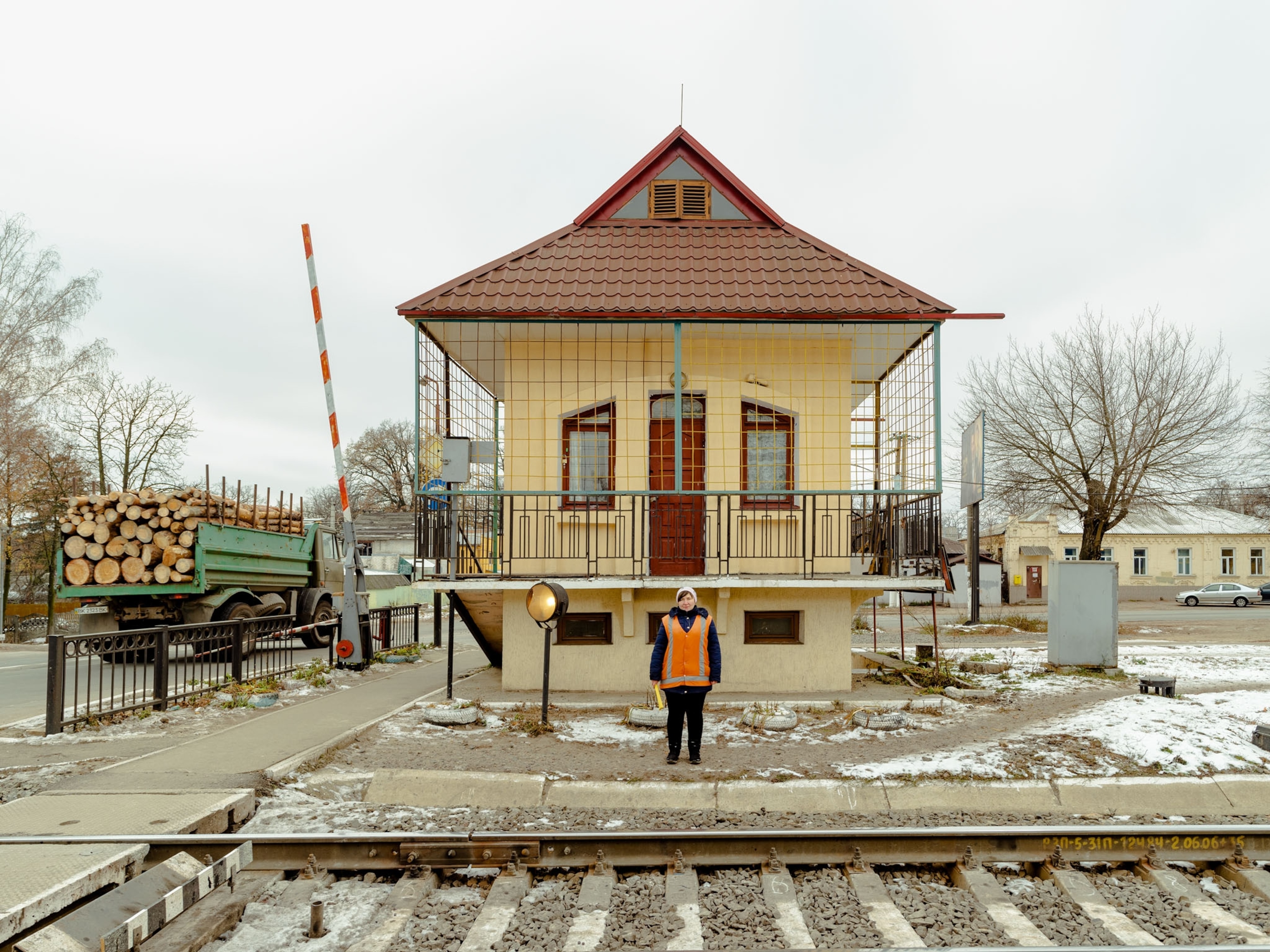Many of Sasha Maslov’s best childhood memories are connected to trains. Every vacation, every trip to another city, he’d stare out the window to see the texture of his country in the apartment buildings and shops and cars waiting for the train to pass. And every so often, he’d see a tiny house with a woman standing by it, holding a yellow flag.
“Ukrainian railroad ladies,” as Maslov calls them in his portrait series, are a cultural tradition that feels as old as rail travel in Ukraine. The workers are tasked with sending flag-based signals to conductors of approaching trains. A folded yellow flag means all clear ahead. An unfolded flag means reduce speed and proceed with caution. A red flag—or a flare shot into the air—means to stop moving entirely, as a hazard is ahead.








Some aspects of rail officer life are changing. The officers are no longer all women, and the Ukraine Railways agency, Ukrzaliznytsia, has expanded its hiring to try to bring more young workers into the unglamorous but stable work.
In a world of high-speed trains and automated crossings, rail attendants today may spend less time signaling to trains than policing and warning motorists. “Ukrainians are notoriously not law-abiding,” Maslov comments. “If there is no watcher, people will go around the barriers to beat a moving train.”
The life can be monastic. In between trains, the workers tend gardens, complete chores, and fill out paperwork. In one house, Maslov saw a notebook in which an attendant had taken down the license plate numbers of cars that ran through barriers. She sent the list to the police.







Related Topics
You May Also Like
Go Further
Animals
- This ‘saber-toothed’ salmon wasn’t quite what we thoughtThis ‘saber-toothed’ salmon wasn’t quite what we thought
- Why this rhino-zebra friendship makes perfect senseWhy this rhino-zebra friendship makes perfect sense
- When did bioluminescence evolve? It’s older than we thought.When did bioluminescence evolve? It’s older than we thought.
- Soy, skim … spider. Are any of these technically milk?Soy, skim … spider. Are any of these technically milk?
- This pristine piece of the Amazon shows nature’s resilienceThis pristine piece of the Amazon shows nature’s resilience
Environment
- This pristine piece of the Amazon shows nature’s resilienceThis pristine piece of the Amazon shows nature’s resilience
- Listen to 30 years of climate change transformed into haunting musicListen to 30 years of climate change transformed into haunting music
- This ancient society tried to stop El Niño—with child sacrificeThis ancient society tried to stop El Niño—with child sacrifice
- U.S. plans to clean its drinking water. What does that mean?U.S. plans to clean its drinking water. What does that mean?
History & Culture
- Séances at the White House? Why these first ladies turned to the occultSéances at the White House? Why these first ladies turned to the occult
- Gambling is everywhere now. When is that a problem?Gambling is everywhere now. When is that a problem?
- Beauty is pain—at least it was in 17th-century SpainBeauty is pain—at least it was in 17th-century Spain
- The real spies who inspired ‘The Ministry of Ungentlemanly Warfare’The real spies who inspired ‘The Ministry of Ungentlemanly Warfare’
- Heard of Zoroastrianism? The religion still has fervent followersHeard of Zoroastrianism? The religion still has fervent followers
Science
- Here's how astronomers found one of the rarest phenomenons in spaceHere's how astronomers found one of the rarest phenomenons in space
- Not an extrovert or introvert? There’s a word for that.Not an extrovert or introvert? There’s a word for that.
- NASA has a plan to clean up space junk—but is going green enough?NASA has a plan to clean up space junk—but is going green enough?
- Soy, skim … spider. Are any of these technically milk?Soy, skim … spider. Are any of these technically milk?
- Can aspirin help protect against colorectal cancers?Can aspirin help protect against colorectal cancers?
Travel
- What it's like to hike the Camino del Mayab in MexicoWhat it's like to hike the Camino del Mayab in Mexico
- Is this small English town Yorkshire's culinary capital?Is this small English town Yorkshire's culinary capital?
- Follow in the footsteps of Robin Hood in Sherwood ForestFollow in the footsteps of Robin Hood in Sherwood Forest
- This chef is taking Indian cuisine in a bold new directionThis chef is taking Indian cuisine in a bold new direction





